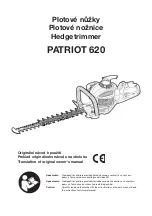
of experience and knowledge if they have been
given supervision or instruction concerning use
of the charger in a safe way and understand the
hazards involved.
•
Children shall not play with the charger.
•
Cleaning and user maintenance shall not be made
by children without supervision.
•
If the supply cord is damaged, it must be replaced
by the manufacturer, its service agent, or similarly
qualified persons in order to avoid a hazard.
•
Disconnect the charger from the power supply and
allow it to cool down before cleaning, maintenance,
storage, and transportation.
•
Before using the charger, read all the instructions
and cautionary markings on the charger and
battery pack.
•
The charger and battery pack supplied with it are
specifically designed to work together. Use the
charger only with the battery pack for this tool.
•
Charge the battery pack indoors only as the
charger is designed for indoor use only.
•
Do not charge non-rechargeable batteries.
•
Protect the charger against moisture and wet
conditions. There is a danger of electric shock.
•
Do not place any object on top of the charger as it
could cause overheating. Do not place the charger
near any heat source.
•
Do not use an extension cord on the charger
unless it is absolutely necessary. The use of an
improper extension cord could cause the risk of
fire, electric shock, or electrocution.
•
Do not use the charger if it has been subjected to
a heavy knock, dropped,or otherwise damaged in
any way. Have the charger checked and repaired
by an authorized service center.
Additional Safety Warnings for Battery Packs
•
Do not attempt to charge the battery pack with any
other charger than the one supplied. The charger
and battery pack supplied with it are specifically
designed to work together.
•
To ensure the longest battery life and best
performance, only charge and store the battery
pack in temperatures that are within the
appropriate range; refer to
Specifications (page
. Do not charge or store the battery pack in
temperatures outside of the suggested range.
•
Small leakage of liquid from the battery pack
may occur under extreme usage or temperature
conditions. However, if the outer seal is broken
and this leakage comes into contact with your
skin, wash the affected area quickly with water. If
the leakage gets in your eyes, flush your eyes with
clean water for a minimum of 10 minutes and seek
immediate medical attention.
•
Never attempt to open the battery pack for any
reason. If the plastic housing of the battery pack
breaks open or cracks, immediately discontinue its
use and do not recharge it.
•
Do not store or carry a spare battery pack in a
pocket or toolbox or any other place where it may
come into contact with metal objects. The battery
pack may short-circuit, causing damage to the
battery pack, burns, or a fire.
•
Do not pierce the battery with nails, strike the
battery with a hammer, step on the battery, or
otherwise subject it to strong impacts or shocks.
•
Protect the battery pack against heat. Do not
place the battery in direct sunlight or use or store
the battery inside cars in hot weather. Doing so
may cause the battery to generate heat, explode
or ignite.
•
Never try to charge a battery pack that is cracked
or damaged in any other way. There is a danger
of electric shock or electrocution.
5
Содержание PowerPlex 51491
Страница 16: ......


































